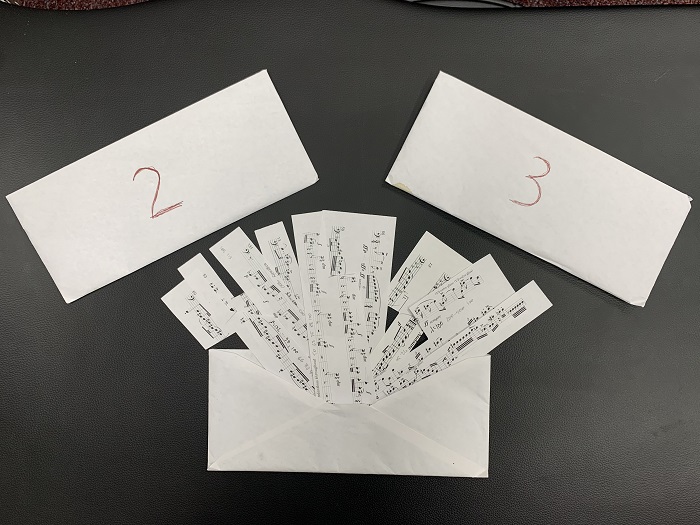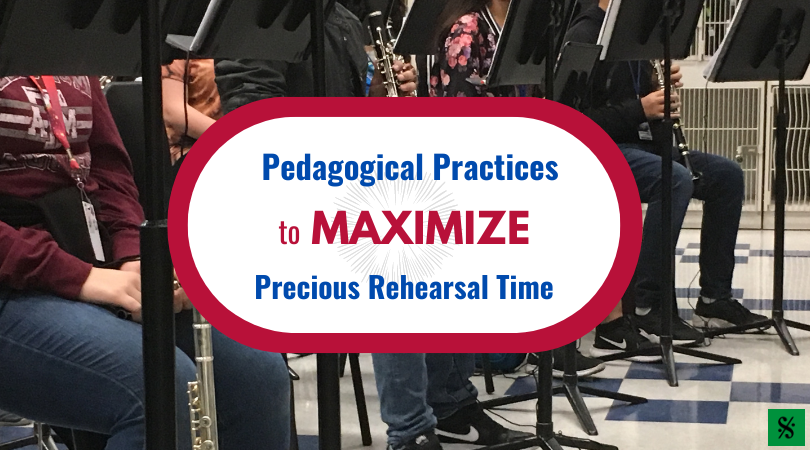Have you ever struggled to prepare repertoire by the performance deadline? Over the course of years preparing various performances, be it orchestral, chamber, or solo work, I have put together a structured plan which has yet to fail me. This plan has four distinct phases with specific objectives:
- Introduction
- Increase Tempo
- Refine
- Mock Performances

Start by selecting the repertoire that you need to learn. This could be music for solo and ensemble, All-State, auditions, a combination of any of the above, or anything else you need to have prepared for a performance. Once the music is selected, make copies of the originals.
On the copies you made, put some kind of mark at the beginning and end of each phrase through the entire piece. Next, cut each piece into single-phrase strips. Sort the strips according to range (high, medium, and low) and divide the categorized strips into three piles equally weighted by range. I usually keep my strips in envelopes: one for each of the three sorted groups of strips. Label them 1, 2, and 3. Now that all the strips are sorted, they need to be randomized.
You can randomize by any means necessary. Make sure there are not two of the same type (high, medium, or low) strips in a row. This seems like a lot of work. It is! However, it is worth the effort. The sorting helps avoid any single practice day being too taxing. Randomizing the strips also helps balance each practice day so that you are not overly fatigued before completing each day’s practice.
One note before we begin. I usually take one day off each week. This gives me time to recover and refresh. So, for my purposes, each practice week consists of six days. Now, on with the four phases.

Phase 1 – Introduction
While using a metronome, bring each strip up to 50% tempo over the course of two weeks. More or less time may be appropriate depending on the performer’s level and the challenge of the piece or pieces being learned.
Length: 2-4 weeks
Objective: Familiarization with the repertoire
Phase 2 – Increasing Tempo
Over the course of two weeks, increase the tempo of all the strips to 100%. Spend a day working on increasing the tempo of each envelope. It should look something like this:
-
- Days 1-3 50-62.5%
- Days 4-6 62.5-75%
- Days 8-10 75-87.5%
- Days 11-13 87.5-100%
At the end of this phase, there will probably be a few strips that still are not the full 100% tempo. This is no big deal. Spend some extra time working these strips up to full tempo. Continue to review the other strips that are already at 100% as you do so.
Take note of the strips you have had to work hardest on to get them to 100%. Work to get these strips to 115%, and they will be easy to perform. I call these “Dailies” because I work on them every day. Continue to work on Dailies throughout the rest of the process.
Length: 2-4 weeks
Objective: Increase tempo from 50%-100%
Phase 3 – Refining
In Phase 3, you will put strips back into context within full pieces. The envelopes are not necessary anymore, nor are the strips. Start practicing from the original or performance copies. In this phase, look for problems that were not present as you learned the strips. Are there transition points between strips in the full piece? Is it challenging to get enough air moving from one phrase to the next? Think of Phases 1 and 2 as gathering the pieces of a puzzle, and Phase 3 as putting those pieces together.
Length: up to 2 weeks
Objective: Combine repertoire into a cohesive whole
Phase 4 – Mock Performances
Now is time to begin performing the music you learned over the last 6-10 weeks. Put yourself in performance situations. Set a goal of at least 10 mock performances. My first performances are usually only for a recording device. However, that can be enough to dredge up a little bit of nervousness. Some other mock performance ideas: play for friends, family, teachers, colleagues, people on the street, anyone who will listen. Live stream on social media, or perform in lower pressure venues. Always record the mock performances. Also, get as much feedback from listeners as possible. Write down everything they say. Thank them for their time and attention!
After your first performance, listen back to the recording while looking at the score or part. Take notes on what you hear. Be as detailed and clear as you need to be to fix problems the next time you practice. Things to listen for: musicality, vibrato, sound quality, rhythm, pitch, accuracy, dynamic contrast, stability, incorrect notes, articulation/note length. If any of those aspects of your performance are not exactly like you want them, take the time to fix it.
The list of items to fix is now your to-do list. Work through the list and mark them off as you complete items. When you finish fixing everything on the list do another recorded mock performance. Repeat this process of performing, recording, listening, and correcting as many times as possible before the actual performance. Make a goal of at least ten mock performances before the real one.
Once you have at least two mock performances under your belt check on whether there are problems present in multiple recordings. Did you miss the high A in measure 105 both times you performed? Did you forget the ritard in measure 9 three times? Find problems from multiple recordings and spend extra time working them out. Eliminate them as soon as you can.
Length: Variable (but probably 4-6 weeks)
Objective: Become comfortable performing this set of repertoire
This plan is great because it provides a focused approach to performance preparation. Rather than spend valuable mental resources deciding what to practice, you can spend it deciding how to fix problems and improve your playing.
Jeremy Lewis is an Associate Professor of Tuba and Euphonium at West Texas A&M University and has been teaching at WT since 2008. He is also the principal tubist with the Amarillo Symphony, a position he has held since 2009. Dr. Lewis is active as a soloist and chamber musician and maintains www.JeremyLewisTuba.com. He lives in Amarillo, TX, with his wife and two daughters.
Related Reading:
Selecting Band Music for Contest – General Guidelines
Preparing Your Non-Varsity Band for Spring Contest and Beyond
The Garner Ensemble Project (Free, Printable Quartets)
If you would like to receive our weekly newsletter, sign up here.
Don’t forget to like us on Facebook too!
Learn. Share. Inspire.
BandDirectorsTalkShop.com






Leave a Reply
You must be logged in to post a comment.